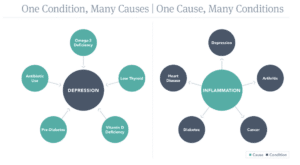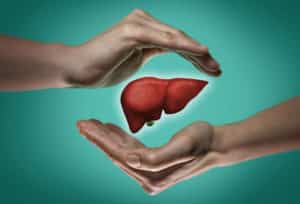When I was battling gut and mood problems, I had no idea that there were root causes to my issues. I knew that I had no control around sugar. I knew that I got overly anxious in situations and my heart would race. I also knew that no matter what I ate, I’d have days where I was horribly constipated!
I dealt with these things every day, and figured they were an unfortunate part of living in my body. I thought I was a healthy person! I exercised. I did yoga. I ate lots of vegetables and drank lots of water. I didn’t understand why despite all of this, I had problems that left me unable to fall asleep at night.
This frustration led me down a road, into the chair of a functional nutritionist.
“You may be eating all of the right things, but you still have some underlying dysfunction that’s causing your symptoms.”
WHAT?! And yet I had a gut feeling this was true.
That’s when a door opened for me, an opening not only to my own healing, but also to a new career path: Functional nutrition. I learned I had a number of root causes, and when I addressed them my mood shifted dramatically. We’re going to talk about the root causes for hormone imbalance, but first let’s differentiate symptoms and root causes.
Imagine a big, strong and beautiful tree. The branches extend out strong and full of green leaves. You can think of these branches as symptoms. We can see them and in this case we see vibrant health. But, then one day we notice that the branches are wilting and the leaves are dying in the middle of early summer. We see symptoms of poor health in our tree, but we can’t see why? The root causes are the why for your symptoms.
In my case, my symptoms were bloating, constipation, body aches, fatigue, and anxiety, among a handful of others. My root causes turned out to be yeast overgrowth, SIBO, sympathetic dominance, HPA Axis dysfunction, and dysglycemia. It’s okay if you’re not sure what all of those things are! That’s what we’ll be going into here in this article!
The main root causes for hormone imbalance are:
- Blood Sugar Imbalance
- Micronutrient Deficiencies
- HPA Axis Dysregulation & Stress
- Microbiome/Gut Issues
- Liver Detoxification Issues
- Aging
So, let’s dig in and discuss these…
Blood Sugar Imbalance:
Blood Sugar Dysregulation often happens from eating the wrong balance of macronutrients. In these cases, we can address the composition of meals and snacks to find improvement right away. In many cases, you may feel a difference within days. You’ll notice as you read this article that some root causes for hormone imbalance will also be root causes for other root causes! This is because the systems in our body are interdependent. There’s a beautiful balance to the human body and we can’t look at these systems as functioning entirely separate from each other. One system impacts other systems! If blood sugar is not functioning well, it may be due to some things we’re going to learn about here in a moment like HPA Axis dysfunction and micronutrient deficiencies.
For blood sugar balance, it’s important to start considering the macronutrient ratios in the foods you eat. A common issue in the states is an over consumption of simple carbohydrates. The Standard American Diet is high in processed grains and sugars, which are high in carbohydrates. These high glycemic foods can spike blood sugar quickly. This causes high levels of insulin to circulate in the body, which can increase androgen synthesis (high testosterone), causing hormone imbalance.
Similarly, if you are estrogen dominant (meaning your estrogen levels are high relative to progesterone), this can be linked to insulin resistance because progesterone helps to stabilize blood sugar. When this happens insulin rises, which is highly inflammatory and causes a cascade of problems, including imbalanced hormones.
It’s also possible that you’re under-eating carbs and this isn’t appropriate for you right now. For example, if you have HPA Axis dysfunction (adrenal fatigue), this may not be a good approach. When we eat low carb, cortisol goes up slightly. If the body is having issues adjusting, then this may cause more problems with hormones. If you have really chronic low energy or temperature regulation issues when you eat low carb, this may be a sign that this isn’t the right approach at least to start.
I often get the question,
“But, then how many carbs per day should I eat?”
In the case of a new client, we usually get a hormone panel and some blood sugar markers, and then we have a better idea of how to build meals. This is ideal for determining the best approach. However, if you’re needing a starting point try this:
Start with a moderate carb diet, which is anywhere from 75 to 150 carbs in a day. I often have my clients start with 100-125, and see how they do with that. Then, we increase it or reduce it from there based on what we observe with energy, brain function, and sleep. If you’re an athlete, it’s likely going to be more. If you’re pregnant, it’s definitely going to be more. If you are dealing with insulin resistance, it may be less.
Make sure to eat a palm-sized portion of protein containing food with every meal and include some healthy fats… avocados, nuts and seeds, olive oil, wild caught salmon and sardines. A fat deficient diet can lead to some serious fertility and hormone issues. If you’re eating less carbs, increase your healthy fat intake, and if you’re eating more carbs, decrease it.
How do you know if it’s working?
You’ll be looking to see if your energy feels more balanced. Your sleep should improve, and your mood should feel steady. To further refine your diet, bloodwork like fasting insulin, glucose, HbA1c, and a hormone panel like the Dutch test can be really useful. If you’re not sure of those things, just start around that moderate range and go from there.
It’s worth noting in this section that with insulin resistance or other dietary imbalances, the body may store an excess of body fat. If this happens, it can result in a low testosterone, high estrogen ratio. This happens due to an enzyme that gets increased in fat tissue, which converts testosterone into estrogen. This is a common cause of estrogen dominance.
In this case, you want to focus on building muscle and eating an appropriate diet to increase muscle mass and decrease body fat percentage.
Micronutrient Deficiencies:
Micronutrients can impact hormones in a number of ways. One is through glucuronidation. This is an enzymatic process that happens in the liver and requires B vitamins, methyl donors, magnesium, calcium D-glucarate, omega 3’s, and zinc to work effectively. If we are lacking in any of these nutrients it can negatively impact this pathway and affect hormone levels.
Cholesterol is vital for healthy hormone production. You need cholesterol to make estrogen, progesterone, and testosterone, but to first make cholesterol, you need NADH, FAD, B1, and lipoic acid. These particular micronutrients are early ingredients for hormone production and again, without them, we can run into issues.
Progesterone production requires NAD and iron, and estrogen creation requires NAD (niacin), iron, zinc, FAD (riboflavin), other B vitamins like pantothenic acid (B5), and Vitamin E. For testosterone to be made, your body needs iron, zinc, small chain fatty acids (and for this we need fiber!), and niacin. Isn’t that amazing?! There can be multiple building blocks for one little process to occur in the body. This is why you may hear how important it is to “eat the rainbow” of vegetables!
These are just a few of the ways that a lack of micronutrients can impact hormone balance. In Part 1, we discussed the birth control pill. The pill depletes the body of some key nutrients and antioxidants, including Vitamins C, E, B vitamins, selenium, and zinc. So, if you’re on the pill or planning to go on it, these are important nutrients to increase in your diet or supplements. Many of these nutrients are needed for fetal development, so if you’re coming off of the pill to get pregnant, you’ll also want to make sure you’re getting optimal levels of these. I like Vibrant America’s micronutrient panel, which can help you assess your levels of essential micronutrients.
HPA Axis Dysfunction & Stress:
Every time I teach a class, I always ask people how often they have stress… daily? Weekly? Monthly?
Typically, they say daily or at least weekly…
We live in a busy world…. As I sit here and write this, we’re in the middle of a pandemic, so there’s a whole new set of stressors that people are grappling with. Because of this, it’s likely that hormone challenges may emerge for many who are navigating this time. If that’s you, keep reading! In part two, I’ll go deeper into steps you can take to transform stress.
Stress is a common cause of hormone imbalance, one of the most common! It decreases the release of gonadotrophin releasing hormone, which can negatively affect other hormones, and it can negatively impact the menstrual cycle. When we perceive a stressor, our cortisol levels increase. Cortisol is a stress hormone and as we’ve seen above, an increase in one hormone will have a cascade of effects on other hormones.
When you’re dealing with stress for weeks, months, or even years, we can end up with HPA Axis dysfunction. This is when communication between the hypothalamus, pituitary, and adrenals goes array. This can make you feel lousy, wondering what happened to your vibrant energy.
Microbiome and Gut Issues:
The health of the gut is vital for overall health, and certainly for healthy hormone levels.
Have you heard of leaky gut? Otherwise known as intestinal permeability. This is what cued me into my own hormone issues. I suspected my challenges with mood had something to do with hormones because I’d also get this cystic acne!
This is what sent me to the seat of a functional nutritionist; when I heard that poor gut health was a cause of hormone problems. Yup, my constipated mess of a self-needed some serious focus on gut health. And it paid off!
I spent eight months working on intestinal permeability (think leaky gut), which causes us to have higher levels of LPS, lipopolysaccharide, in the blood. This produces inflammation and this can disrupt hormone levels.
A common cause of estrogen dominance, which I run into often in practice involves the estrobolome. This refers to specific bacteria in the gut that are responsible for regulating estrogen in the body. Our ability to recycle and reuse estrogen impacts the amount of estrogen in the body and it’s in the gut where much of this occurs. B-glucuronidase is an enzyme that is produced by the colonic flora. It will break the glucuronide bonds of the conjugated estrogen molecule. This allows estrogen, now fully active, to be re-absorbed into the bloodstream. Often the liver is then not able to eliminate as much estrogen from the body. In this case the body may even up-regulate sex hormone binding globulin to try to bind estrogen, but it will preferentially bind to testosterone and this can lead to low testosterone. If that was confusing, just know that your gut health is VITAL for healthy hormone levels 🙂
Certain gut bacteria can produce estrogen-like compounds from the foods you eat. So, if you have dysbiosis (an imbalance of bacteria in the gut), it could also be affecting estrogen levels. That’s why we always look at gut health as a root cause in hormone imbalance.
Liver Detoxification Issues:
Your liver is this amazing master recycler. It breaks things down, determines what can be reused, and throws away the trash. For estrogen, it uses a process called glucuronidation. The broken-down estrogen parts get put into the bile and stored in the gallbladder until we eat a fatty meal. Then, the bile is sent into the small intestine. When working smoothly, these broken-down estrogen molecules and other toxins get sent out of the body in the stool.
So, if glucuronidation in your liver isn’t working effectively, it could cause problems in eliminating estrogen. And looking back to gut health, if there’s pathogenic bacteria in the gut, they will produce endotoxins. These endotoxins screw up glucuronidation in the liver and thus we can end up with high estrogen. Gut health and liver health go hand in hand!
There’s a sulfation pathway in the liver that needs to be working well to detoxify estrogens as well, and some other pathways that are involved in the metabolism of progesterone and testosterone.
Environmental toxins have a detrimental effect on hormone levels.
Triclosan, a chemical commonly found in beauty products, can increase estrogen levels. There are a number of metals that can bind to estrogen receptors and have estrogenic affects in the body, such as aluminum, copper, lead, and mercury among others. Many plastics contain xenoestrogens, which are chemicals that mimic estrogen and can interfere with the function of your body’s natural estrogen. Making sure someone doesn’t have overly high levels of all of these metals and other environmental toxins is important for managing estrogen levels.
Exposure to environmental toxins typically occurs over time, and often people don’t realize this is an issue. These toxins are found in the food supply, cleaning products, body care, lotions, and fragrances. It’s important to consider everything we put in and on our body, and also the things we inhale throughout the day. Many of them can be tested for and are an important part of resolving hormone issues.
We’re all inevitably aging…
I just turned forty this year and am looking so forward to this decade of life! With it or soon after it will likely come inevitable hormone shifts. As we ladies age, progesterone decreases faster than estrogen and this can lead to estrogen dominance. As we head into perimenopause and menopause, we’re going to have some pretty significant shifts in hormones in general. After menopause, the adrenals and adipocytes (fat cells) will be the primary producer of female hormones. If you’ve been riddled with stress for years, and the HPA axis is damaged, this is a big focus for support during menopause and after.
Address your root causes to get back on track!
There it is! The main root causes of hormone imbalance. To get your mood, sleep, and energy issues sorted out, you’ll want to figure out what yours are. It’s important to work with someone qualified to identify these, and help you get some plans in place to fix them.
And That’s ultimately what it’s about, right? To be able to get up and be the badass, awesome person that you are, full of vim and vigor!
Post your questions and comments here on the blog!
If you’d like to get the ball rolling, feel free to book a complimentary 30-minute discovery chat and I’ll get you some tips to start looking into your root causes.
In the meantime, stay tuned for Parts 3 & 4 to start tailoring your foods and including supplements to balance your hormones naturally.
See you soon lovely!








